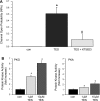Testosterone-induced relaxation of coronary arteries: activation of BKCa channels via the cGMP-dependent protein kinase
- PMID: 22081702
- PMCID: PMC3334243
- DOI: 10.1152/ajpheart.00046.2011
Testosterone-induced relaxation of coronary arteries: activation of BKCa channels via the cGMP-dependent protein kinase
Abstract
Androgens are reported to have both beneficial and detrimental effects on human cardiovascular health. The aim of this study was to characterize nongenomic signaling mechanisms in coronary artery smooth muscle (CASM) and define the ionic basis of testosterone (TES) action. TES-induced relaxation of endothelium-denuded porcine coronary arteries was nearly abolished by 20 nM iberiotoxin, a highly specific inhibitor of large-conductance, calcium-activated potassium (BK(Ca)) channels. Molecular patch-clamp studies confirmed that nanomolar concentrations of TES stimulated BK(Ca) channel activity by ∼100-fold and that inhibition of nitric oxide synthase (NOS) activity by N(G)-monomethyl-L-arginine nearly abolished this effect. Inhibition of nitric oxide (NO) synthesis or guanylyl cyclase activity also attenuated TES-induced coronary artery relaxation but did not alter relaxation due to 8-bromo-cGMP. Furthermore, we detected TES-stimulated NO production in porcine coronary arteries and in human CASM cells via stimulation of the type 1 neuronal NOS isoform. Inhibition of the cGMP-dependent protein kinase (PKG) attenuated TES-stimulated BK(Ca) channel activity, and direct assay determined that TES increased activity of PKG in a concentration-dependent fashion. Last, the stimulatory effect of TES on BK(Ca) channel activity was mimicked by addition of purified PKG to the cytoplasmic surface of a cell-free membrane patch from CASM myocytes (∼100-fold increase). These findings indicate that TES-induced relaxation of endothelium-denuded coronary arteries is mediated, at least in part, by enhanced NO production, leading to cGMP synthesis and PKG activation, which, in turn, opens BK(Ca) channels. These findings provide a molecular mechanism that could help explain why androgens have been reported to relax coronary arteries and relieve angina pectoris.
Figures







Similar articles
-
Endothelium-derived nitric oxide inhibits the relaxation of the porcine coronary artery to natriuretic peptides by desensitizing big conductance calcium-activated potassium channels of vascular smooth muscle.J Pharmacol Exp Ther. 2010 Jul;334(1):223-31. doi: 10.1124/jpet.110.166652. Epub 2010 Mar 23. J Pharmacol Exp Ther. 2010. PMID: 20332186
-
Nitric oxide and protein kinase G act on TRPC1 to inhibit 11,12-EET-induced vascular relaxation.Cardiovasc Res. 2014 Oct 1;104(1):138-46. doi: 10.1093/cvr/cvu190. Epub 2014 Aug 18. Cardiovasc Res. 2014. PMID: 25139746
-
H2O2-induced dilation in human coronary arterioles: role of protein kinase G dimerization and large-conductance Ca2+-activated K+ channel activation.Circ Res. 2012 Feb 3;110(3):471-80. doi: 10.1161/CIRCRESAHA.111.258871. Epub 2011 Dec 8. Circ Res. 2012. PMID: 22158710 Free PMC article.
-
Redox regulation of guanylate cyclase and protein kinase G in vascular responses to hypoxia.Respir Physiol Neurobiol. 2010 Dec 31;174(3):259-64. doi: 10.1016/j.resp.2010.08.024. Epub 2010 Sep 8. Respir Physiol Neurobiol. 2010. PMID: 20831906 Free PMC article. Review.
-
Cardiovascular and metabolic actions of the androgens: Is testosterone a Janus-faced molecule?Biochem Pharmacol. 2023 Feb;208:115347. doi: 10.1016/j.bcp.2022.115347. Epub 2022 Nov 15. Biochem Pharmacol. 2023. PMID: 36395900 Review.
Cited by
-
Androgen deprivation therapy and cardiovascular disease: what is the linking mechanism?Ther Adv Urol. 2016 Apr;8(2):118-29. doi: 10.1177/1756287215617872. Epub 2015 Nov 30. Ther Adv Urol. 2016. PMID: 27034724 Free PMC article. Review.
-
Testosterone decreases urinary bladder smooth muscle excitability via novel signaling mechanism involving direct activation of the BK channels.Am J Physiol Renal Physiol. 2016 Dec 1;311(6):F1253-F1259. doi: 10.1152/ajprenal.00238.2016. Epub 2016 Sep 7. Am J Physiol Renal Physiol. 2016. PMID: 27605581 Free PMC article.
-
Expression and Regulation of Brain Natriuretic Peptide and Natriuretic Peptide Receptor A (NPR-A) in L6-S1 Dorsal Root Ganglia in a Rat Model of Chronic Nonbacterial Prostatitis.Med Sci Monit. 2019 Nov 28;25:9042-9047. doi: 10.12659/MSM.915619. Med Sci Monit. 2019. PMID: 31777403 Free PMC article.
-
Role of platelet factor 4 in arteriovenous fistula maturation failure: What do we know so far?J Vasc Access. 2024 Mar;25(2):390-406. doi: 10.1177/11297298221085458. Epub 2022 Jun 24. J Vasc Access. 2024. PMID: 35751379 Free PMC article. Review.
-
Calcium- and voltage-gated BK channels in vascular smooth muscle.Pflugers Arch. 2018 Sep;470(9):1271-1289. doi: 10.1007/s00424-018-2151-y. Epub 2018 May 11. Pflugers Arch. 2018. PMID: 29748711 Free PMC article. Review.
References
-
- Bowles DK, Maddali KK, Ganjam VK, Rubin LJ, Tharp DL, Turk JR, Heaps CL. Endogenous testosterone increases L-type Ca2+ channel expression in porcine coronary smooth muscle. Am J Physiol Heart Circ Physiol 287: H2091–H2098, 2004 - PubMed
-
- Cairrao E, Santos-Silva AJ, Verde I. PKG is involved in testosterone-induced vasorelaxation of human umbilical artery. Eur J Pharmacol 640: 94–101, 2010 - PubMed
-
- Ceballos G, Figueroa L, Rubio I, Gallo G, Garcia A, Martinez A, Yanez R, Perez J, Morato T, Chamorro G. Acute and nongenomic effects of testosterone on isolated and perfused rat heart. J Cardiovasc Pharmacol 33: 691–697, 1999 - PubMed
-
- Chou TM, Sudhir K, Hutchison SJ, Ko E, Amidon TM, Collins P, Chatterjee K. Testosterone induces dilation of canine coronary conductance and resistance arteries in vivo. Circulation 94: 2614–2619, 1996 - PubMed
Publication types
MeSH terms
Substances
Grants and funding
LinkOut - more resources
Full Text Sources
Molecular Biology Databases

